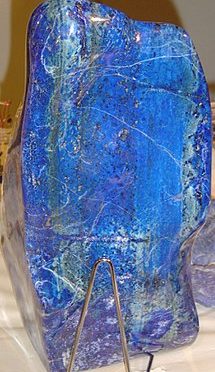| 地質年代:公元前七千年 |
Geological Age: 7th millennium BC |
| 形成:青金石是由接觸交代變質作用形成,主要賦存於矽酸鹽 – 鎂質矽卡岩中和鈣質矽卡岩中
|
Formation: Lapis Lazuli is formed by contact metamorphism and occurs mainly in silicate-magnesian skarns and in calcareous skarns.
|
| 特性:青金石,多礦物集合體。青金石礦物的化學成分為鈉鈣的鋁矽酸鹽,其化學式為(Na,Ca)8(AlSiO4)6(SO4,S,Cl)2,常呈緻密塊狀集合體,單晶為菱形十二面體,但極為罕見,顏色為深藍色、天藍色、紫藍色和綠藍色,摩氏硬度5-5.5,相對密度2.38~2.45。
|
Properties: Lapis Lazuli,a multi-mineral assemblage.Lapis Lazuli minerals are dominant, and the chemical composition of lapis lazuli minerals is sodium calcium silicate, whose chemical formula is (Na,Ca)8(AlSiO4)6(SO4,S,Cl)2, and often shows a dense block. Assemblies, single crystal diamond-shaped dodecahedron, but very rare, the color is dark blue, sky blue, purple blue and green blue, Mohs hardness 5-5.5, relative density of 2.38 ~ 2.45. |
| 用途:青金石具有出色的拋光效果,可以製作成珠寶,雕刻,盒子,馬賽克,裝飾品,小雕像和花瓶。 在文藝復興時期,青金石被磨光並加工成顏料群青,用於壁畫和油畫。 其作為油漆中顏料的用途基本上在19世紀初,當化學相同的合成品變得可用時結束。 |
Application: Lapis lazuli has excellent polishing effects and can be made into jewelry, carvings, boxes, mosaics, ornaments, figurines and vases. During the Renaissance, lapis lazuli was polished and processed into pigmented ultramarines for frescoes and paintings. Its use as a pigment in paints was basically completed in the early 19th century when chemically identical synthetics became available. |
| 分佈:阿富汗、俄羅斯、塔吉克斯坦、智利、加拿大
|
Distribution: Afghanistan, Russia, Tajikistan, Chile, Canada
|
